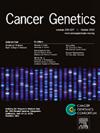HER2、KRAS和PIK3CA在子宫颈神经内分泌癌中的突变及其对肿瘤驱动靶向治疗的意义
IF 2.1
4区 医学
Q4 GENETICS & HEREDITY
引用次数: 0
摘要
目的her2介导的RAS/MAPK和PI3K/AKT信号失调可导致细胞生长和肿瘤发生失控。我们之前报道了晚期子宫颈神经内分泌癌(NEC)中频繁发生HER2突变,本研究通过研究KRAS和PIK3CA作为12名台湾宫颈NEC女性的潜在治疗靶点,扩大了基因组图谱。方法对台湾12例经组织学证实的宫颈NEC肿瘤标本进行分析。靶向下一代测序(NGS)使用定制的Qiagen GeneRead DNAseq Targeted Panels V2进行,这是一种临床相关的肿瘤面板,用于检测关键癌基因的突变。从福尔马林固定石蜡包埋(FFPE)组织中提取DNA,然后进行变异分析以确定致病性改变。结果在同一队列中,除了HER2突变(41.67%,5/12)外,我们还检测到KRAS(16.67%, 2/12)和PIK3CA(16.67%, 2/12)的致病性改变。在HER2/KRAS(8.3%, 1/12)和HER2/PIK3CA(8.3%, 1/12)中观察到并发突变,提示潜在的协同效应。本研究发现HER2、KRAS和PIK3CA是宫颈NEC的潜在关键驱动因素,它们的共同出现突出了RAS/MAPK和PI3K/AKT通路在发病机制中的作用。在这种侵袭性的、治疗有限的疾病中,双途径抑制与多靶点治疗可以提高疗效并解决耐药性。分子谱分析对精确肿瘤学至关重要,为在更大的队列中验证这些发现铺平了道路,并为提高生存率和生活质量制定了多途径策略。本文章由计算机程序翻译,如有差异,请以英文原文为准。
Profiling of HER2, KRAS, and PIK3CA mutations in uterine cervical neuroendocrine carcinoma and implications for oncogenic driver targeting therapy
Purpose
Dysregulated HER2-mediated RAS/MAPK and PI3K/AKT signaling drive uncontrolled cell growth and tumorigenesis. Following our prior report of frequent HER2 mutations in advanced uterine cervical neuroendocrine carcinoma (NEC), this study expands the genomic landscape by investigating KRAS and PIK3CA as potential therapeutic targets in a cohort of 12 Taiwanese women with cervical NEC.
Methods
We analyzed 12 histologically confirmed cervical NEC tumor samples from Taiwanese patients. Targeted next-generation sequencing (NGS) was performed using a custom Qiagen GeneRead DNAseq Targeted Panels V2, a clinically relevant tumor panel to detect mutations in key oncogenes. DNA was extracted from formalin-fixed, paraffin-embedded (FFPE) tissues, followed by variant analysis to identify pathogenic alterations.
Results
Beyond HER2 mutations (41.67 %, 5/12), we detected pathogenic alterations in KRAS (16.67 %, 2/12) and PIK3CA (16.67 %, 2/12) within the same cohort. Concurrent mutations were observed in HER2/KRAS (8.3 %, 1/12) and HER2/PIK3CA (8.3 %, 1/12), indicating potential cooperative effects.
Conclusion
This study identifies HER2, KRAS, and PIK3CA as potentially critical drivers in cervical NEC, with their co-occurrence highlighting the role of RAS/MAPK and PI3K/AKT pathways in pathogenesis. Dual pathway inhibition with multi-target therapies may enhance efficacy and address resistance in this aggressive, treatment-limited disease. Molecular profiling is essential for precision oncology, paving the way for validating these findings in larger cohorts and developing multi-pathway strategies to improve survival and quality of life.
求助全文
通过发布文献求助,成功后即可免费获取论文全文。
去求助
来源期刊

Cancer Genetics
ONCOLOGY-GENETICS & HEREDITY
CiteScore
3.20
自引率
5.30%
发文量
167
审稿时长
27 days
期刊介绍:
The aim of Cancer Genetics is to publish high quality scientific papers on the cellular, genetic and molecular aspects of cancer, including cancer predisposition and clinical diagnostic applications. Specific areas of interest include descriptions of new chromosomal, molecular or epigenetic alterations in benign and malignant diseases; novel laboratory approaches for identification and characterization of chromosomal rearrangements or genomic alterations in cancer cells; correlation of genetic changes with pathology and clinical presentation; and the molecular genetics of cancer predisposition. To reach a basic science and clinical multidisciplinary audience, we welcome original full-length articles, reviews, meeting summaries, brief reports, and letters to the editor.
 求助内容:
求助内容: 应助结果提醒方式:
应助结果提醒方式:


